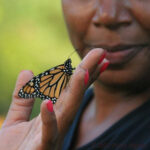Bee-flies are nature’s little tricksters. These insects, often described as tiny, fluffy, flying narwhals, are masters of disguise. With their hairy bodies, adorable faces, and long, straw-like tongues, it’s easy to mistake them for bees buzzing around your garden. However, these nectar-seeking creatures are actually flies, belonging to a fascinating group with a unique and sometimes surprising lifestyle. If you’ve ever seen a “bee that looks like a fly,” you’ve likely encountered a bee-fly.
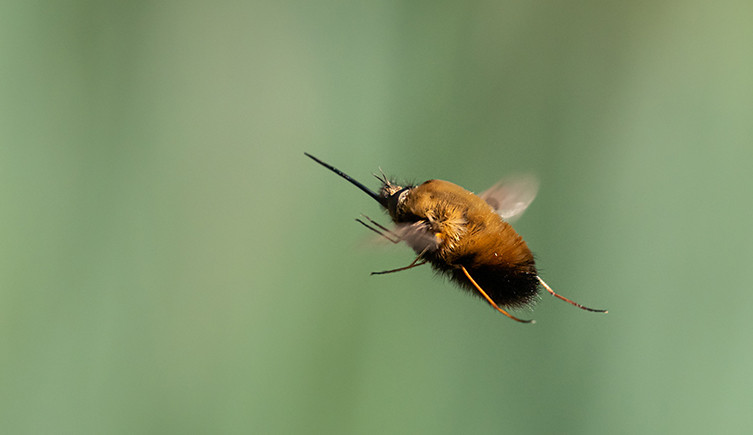 A bee-fly in mid air with wings and legs outstretched
A bee-fly in mid air with wings and legs outstretched
The long proboscis of Bombylius bee-flies can be mistaken for a stinger, but they are harmless and use it to sip nectar. © Stefan Rotter/ Shutterstock.com
Do Bee-Flies Sting? Debunking the Myth
Despite their convincing bee costume, bee-flies are completely unable to sting, and they don’t bite either. That long, prominent mouthpart, which might look intimidatingly like a stinger or a mosquito’s proboscis, is actually a proboscis. They use this straw-like appendage exclusively for feeding on nectar from flowers. Their focus is solely on finding food, potential mates, and suitable spots to lay their eggs, not on defense or aggression towards humans. So, you can admire these bee mimics without any fear of being stung.
Bee or Bee-Fly? Unmasking the Imposter
If you encounter an insect that looks like a bee, but something seems a little off, pay close attention to a few key features to determine if it’s actually a bee-fly. The most reliable way to tell them apart is by examining their wings. Bees have two pairs of wings which they typically fold neatly against their body when at rest. Bee-flies, on the other hand, possess only one pair of wings. You’ll notice they hold their wings out to the sides when resting.
Another distinguishing characteristic lies in their antennae. Bee-flies have short, stubby antennae, whereas bees have noticeably longer antennae. Finally, observe their flight pattern. Bee-flies are renowned for their hovering ability, often hanging in mid-air with remarkable steadiness as they feed from flowers. While some bees, like hairy-footed flower bees, can also hover, bee-flies are particularly adept at this, and their overall flight style is quite distinctive. These subtle differences will help you confidently identify these bee imposters.
How to Spot a Bee-Fly in Your Garden
To witness a bee-fly in action, venture outdoors on a warm spring day. The dark-edged bee-fly (Bombylius major) is the most common species in the UK and is a prime example of “A Bee That Looks Like A Fly”. You might first hear their distinctive high-pitched hum before you actually spot them.
This species is widespread throughout England, Wales, and Scotland, thriving in diverse environments, from urban gardens and city parks to woodlands and coastal areas. They are among the earliest bee-flies to emerge in the year, typically appearing from March onwards after overwintering as pupae. On unusually warm days, sightings can even occur as early as mid-February. However, they are sun-loving insects and generally prefer temperatures above 17°C (around 63°F) for flight.
When they’re not darting between blossoms, these sun-worshippers often bask on bare soil or dead leaves, soaking up the warmth.
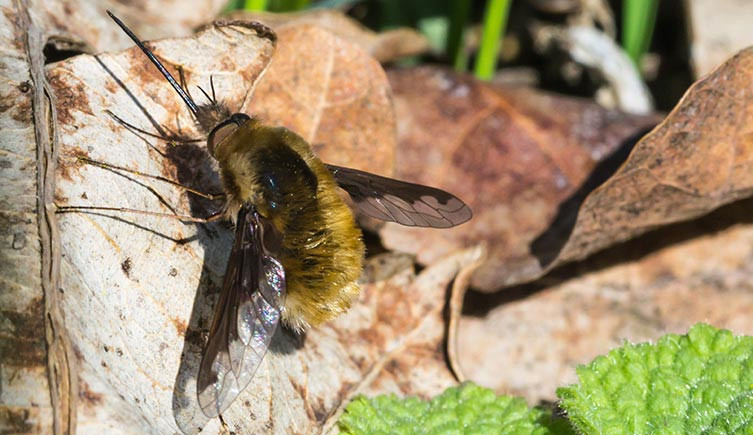 A dark-edged bee-fly resting on a leaf
A dark-edged bee-fly resting on a leaf
The dark-edged bee-fly (Bombylius major) is the most frequently seen bee-fly in the UK. © Russia piton/ Shutterstock.com
When resting, the dark-edged bee-fly, with its wings pointed slightly upwards, can resemble a miniature stealth bomber. Look for the characteristic dark band that edges the front of its wings to aid in identification.
Depending on your location, you might also encounter the dotted bee-fly (Bombylius discolor) during springtime. Currently, this species is primarily found along the south Wales coast and across southern England, extending as far north as the Midlands, but their range is expanding northward. To identify the dotted bee-fly, you’ll need to observe it at rest to appreciate the delicate dots that adorn its wings.
While the UK is home to ten bee-fly species in total, two other Bombylius species share the same plump, fluffy bumblebee-like appearance and long proboscis, but they are considerably rarer than the dark-edged and dotted bee-flies.
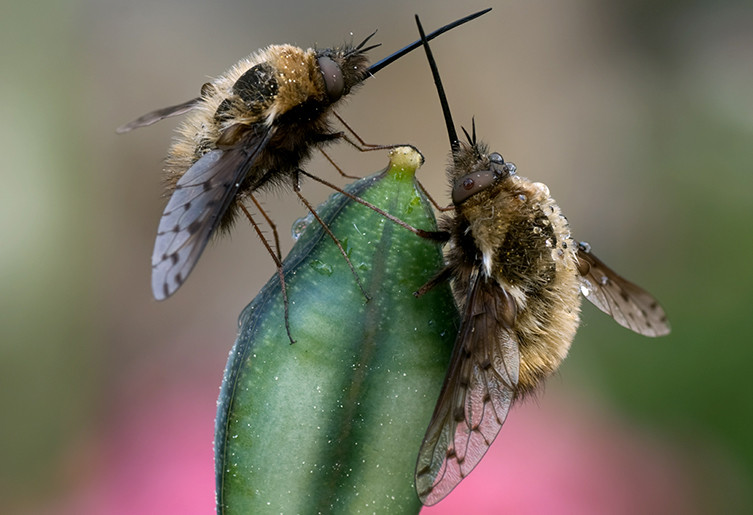 Two bee-flies with dotted wings and long mouthparts
Two bee-flies with dotted wings and long mouthparts
Two dotted bee-flies (Bombylius discolor) covered in morning dew, resting on a flower bud. © Marek R Swadzba/ Shutterstock.com
The Secret Life of Bee-Fly Larvae: Gruesome Parasites
While adult bee-flies are undeniably charming, the larval stage reveals a less endearing aspect of their life cycle. Bee-fly larvae are parasitoids, meaning they are parasites that ultimately kill their host.
Many bee-fly species target bees and wasps as hosts, but some species parasitize beetles, grasshoppers, ants, moths, or caterpillars.
Dr. Erica McAlister, Senior Curator of Diptera at the Museum, explains the fascinating yet grim process of egg-laying in dark-edged bee-flies and the unfortunate fate of solitary bee larvae. The female bee-fly begins by performing a “twerking” motion with her abdomen to scoop up sand and gravel, coating her eggs with this material. This sandy coating serves as both protection and camouflage for the eggs, and adds weight to aid in their dispersal.
The female bee-fly then flies to a solitary bee’s nest and, while hovering, flicks her eggs towards the entrance, hoping they will hatch near or inside the nest. Dark-edged bee-flies possess a spine on their ovipositor (egg-laying tube) specifically adapted for this “bombing” technique, allowing them to launch a volley of eggs in quick succession while the host bee is away from its nest.
A female dotted bee-fly uses its egg-flicking technique while hovering near the nest entrance of a mining bee, its host. This egg-laying method is characteristic of all Bombylius bee-fly species. © Nick Upton/ Alamy Stock Photo
This rapid egg-laying is crucial because bee-flies face competition from other parasites, including flies and wasps, also seeking to exploit solitary bees. Dr. McAlister vividly describes the scene as “carnage and mayhem” in your garden.
Once hatched, bee-fly larvae are remarkably active. Equipped with false legs, they actively crawl into the bee burrows. Initially, they may consume the pollen stores intended for the bee larvae. Then, they undergo a rare second metamorphosis called hyper-metamorphosis. Dr. McAlister likens this transformation to going “from an active toddler to an enormous, sedentary teenage larva that eats the bee grubs.” In this final larval stage, they become predators, consuming the developing bee larvae.
Parasitism is a widespread strategy in the animal kingdom, with scientists estimating that around 40% of all described insect species are parasitic, and this figure is likely an underestimate. Despite their parasitic larval stage, bee-flies are considered a natural part of a healthy ecosystem and do not pose a threat to solitary bee populations. Dr. McAlister points out the intricate web of parasitism, stating, “You can have a wasp that is a parasite of a spider and then a bee-fly that is a parasite of the wasp, so it’s a parasite of a parasite, which is quite fun and interesting.”
Bee-Flies: Unsung Pollinator Heroes
Despite their somewhat sinister larval habits, adult bee-flies are valuable pollinators, just like bees. The dark-edged bee-fly’s long, straw-like proboscis is perfectly adapted to reach nectar deep within certain flower shapes, such as primroses. They can also extend their mouthparts to access nectar in a variety of other flower types.
A dark-edged bee-fly prepares to sip nectar from a primrose. Its proboscis is long enough to reach the nectar at the base of the flower. © Bill Coster/ Alamy Stock Photo
Dr. McAlister describes their feeding technique: “The bee-fly holds itself to the flower with its front legs and then feeds while buzzing mid-air.” Their exceptional hovering ability allows them to feed efficiently while remaining airborne.
As they feed, pollen adheres to their proboscis and body hairs. This pollen is then inadvertently transferred to the next flower they visit in their ongoing search for nectar, effectively contributing to pollination.
However, not all bee-flies are diligent pollinators in every feeding instance. Some employ a “nectar-robbing” technique, where they pierce the base of the flower to access nectar without going through the flower’s opening. This shortcut deprives the plant of pollination. Interestingly, some bees also exhibit this nectar-robbing behavior.
Bee-flies, like humans, have flower color preferences. They show a particular fondness for flowers in the purple, violet, blue, or white color ranges, and are less attracted to bright yellow or pink blooms.
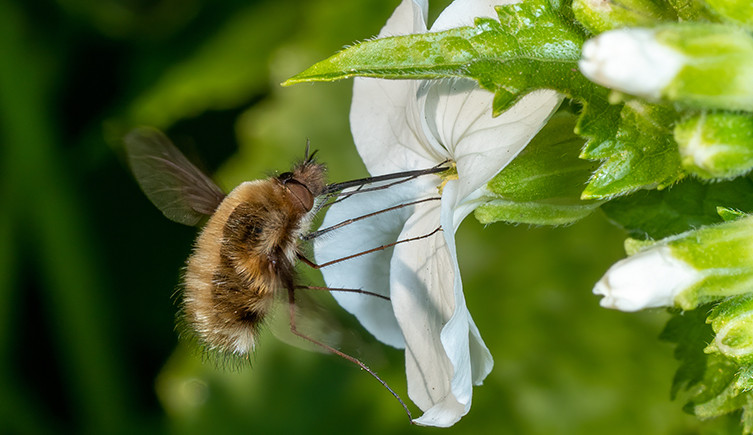 A bee-fly feeds on a flower
A bee-fly feeds on a flower
A dark-edged bee-fly foraging for nectar. White flowers are particularly favored by bee-flies. © Keith Hider/ Shutterstock.com
A Guide to UK Bee-Fly Species
If you’re keen to identify the “bee that looks like a fly” in your area, here’s a guide to some of the bee-fly species you might encounter in the UK:
Dark-edged Bee-fly (Bombylius major)
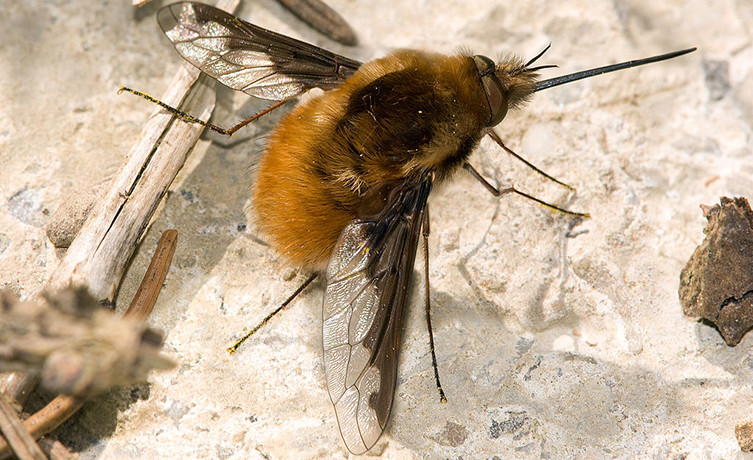 A dark-edged bee-fly rests on a path
A dark-edged bee-fly rests on a path
Despite being called the greater or large bee-fly, the dark-edged bee-fly is only slightly over a centimeter in body length. © Richard Bartz (CC BY-SA 2.5) via Wikimedia Commons
When to See It: March (occasionally mid-February) to late June.
Where to See It: Widespread across England, Wales, and Scotland (see distribution map) in diverse habitats including parks and gardens.
Dotted Bee-fly (Bombylius discolor)
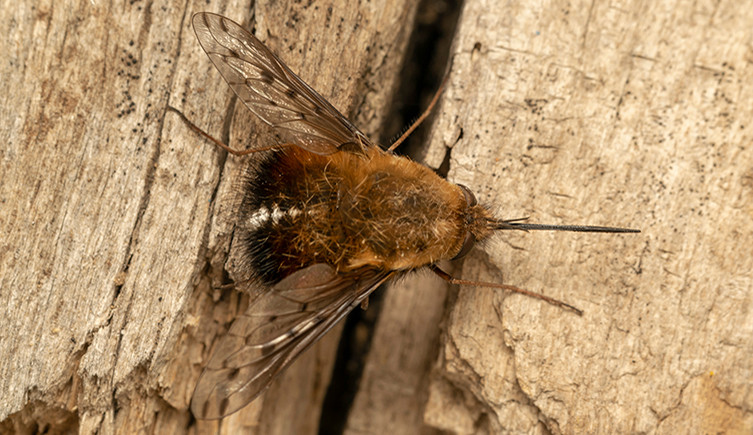 A bee-fly with dotted wings and spots on its furry abdomen
A bee-fly with dotted wings and spots on its furry abdomen
The dotted bee-fly is recognized by its beautiful dotted wings. The female also has a distinctive line of white dots on her abdomen. © tasnenad/ Shutterstock.com
When to See It: Late March to mid-June.
Where to See It: Southern England and the southern coast of Wales (see distribution map) in various habitats including parks, gardens, and allotments.
Western Bee-fly (Bombylius canescens)
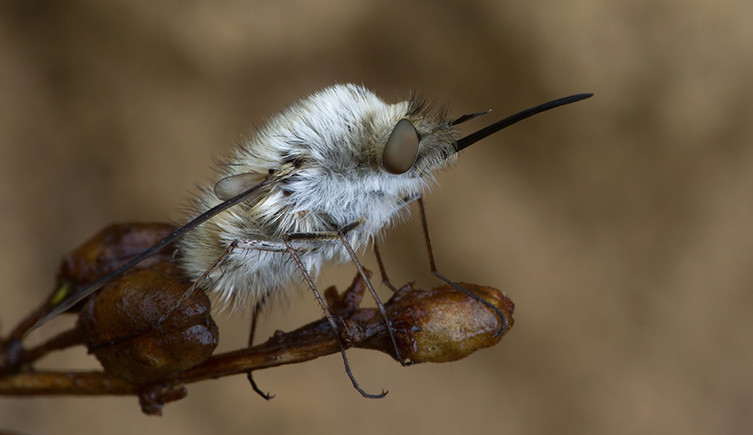 A fluffy, white bee fly with a long mouthpart sits on a dry stalk
A fluffy, white bee fly with a long mouthpart sits on a dry stalk
The western bee-fly is characterized by its unmarked wings and overall pale appearance. © cilko1/ Shutterstock.com
When to See It: Early May to mid-August.
Where to See It: Southwest England and southern Wales (see distribution map) in flowery grassland habitats, including hillsides and riverbanks.
Heath Bee-fly (Bombylius minor)
The heath bee-fly, now mostly restricted to Dorset heathlands, has been recorded in scattered locations in the past. © Stephan Czuratis/ Shutterstock.com
When to See It: Early July to late August.
Where to See It: Heathland and sandy banks in east Dorset and the Isle of Man.
Villa Bee-fly (Villa cingulata, V. modesta and V. venusta)
 A bee-fly with a stripey abdomen landed on sand
A bee-fly with a stripey abdomen landed on sand
Villa bee-flies are less rounded than Bombylius species, with shorter proboscis and more tapered abdomens. The dune villa (Villa modesta, pictured) is the most frequently seen of the three UK species. © S Rae (CC BY 2.0) via Flickr
When to See Them: June to September.
Where to See Them: V. cingulata: southern England, typically in areas with sparse vegetation. V. modesta: coastal dunes. V. venusta: heathland in Surrey, Dorset and Devon.
Mottled Bee-fly (Thyridanthrax fenestratus)
The mottled bee-fly is identified by its short proboscis, patterned body, and distinctively mottled wings. © Dom Greves/ Alamy Stock Photo
Where to See It: Heathland in Dorset, New Forest, Surrey, West Sussex and Berkshire (see distribution map).
Flea Bee-fly (Phthiria pulicaria)
When to See It: Late May to mid-August.
Where to See It: Coastal dunes around the UK and sandy heaths in East Anglia.
Black-winged Bee-fly (Anthrax anthrax)
The black-winged bee-fly, named Anthrax (Greek for coal), is a recent arrival to the UK and is easily recognized by its very dark, non-bee-like appearance. © Frank Vassen (CC BY 2.0)
Where to See It: Currently recorded in Cambridge and Canterbury.
Become a Bee-Fly Watcher
If you spot a “bee that looks like a fly”, contribute to citizen science by recording your sighting on the Bee-fly Watch website.
Your records provide valuable data for scientists studying the distribution and flight periods of bee-flies in the UK and how these patterns are changing over time. To further contribute to research on bee-fly emergence, you can also note whether you observed a male or female bee-fly. Males are identifiable by their large eyes that meet at the top of their head, while females have smaller, separated eyes. Every observation helps to build a clearer picture of these fascinating bee mimics.
